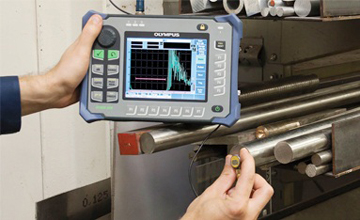Ultasonic Testing
Ultasonic Testing
 In ultrasonic testing, an ultrasound transducer connected to a diagnostic machine is passed over the object being inspected.
In ultrasonic testing, an ultrasound transducer connected to a diagnostic machine is passed over the object being inspected.
There are two methods of receiving the ultrasound waveform, reflection and attenuation. In reflection (or pulse-echo) mode, the transducer performs both the sending and the receiving of the pulsed waves as the "sound" is reflected back to the device. Reflected ultrasound comes from an interface, such as the back wall of the object or from an imperfection within the object. The diagnostic machine displays these results in the form of a signal with an amplitude representing the intensity of the reflection and the distance, representing the arrival time of the reflection.
In attenuation (or through-transmission) mode, a transmitter sends ultrasound through one surface, and a separate receiver detects the amount that has reached it on another surface after traveling through the medium. Imperfections or other conditions in the space between the transmitter and receiver reduce the amount of sound transmitted, thus revealing their presence. Using the couplet increases the efficiency of the process by reducing the losses in the ultrasonic wave energy due to separation between the surfaces.
